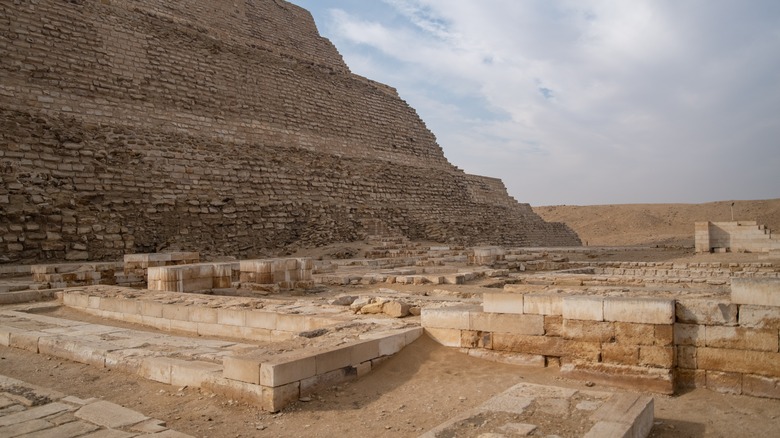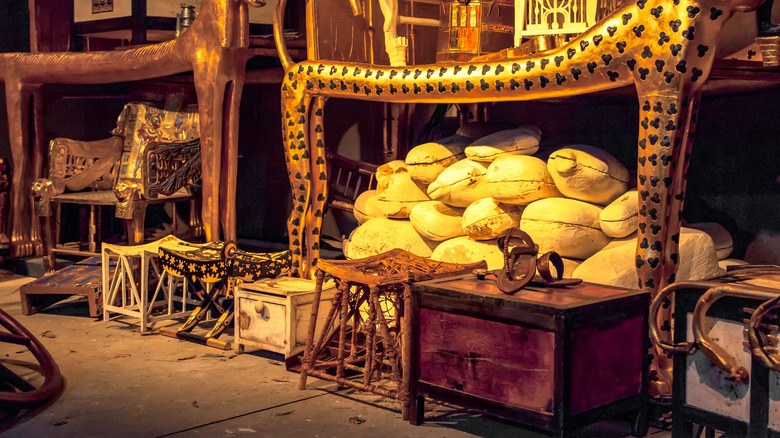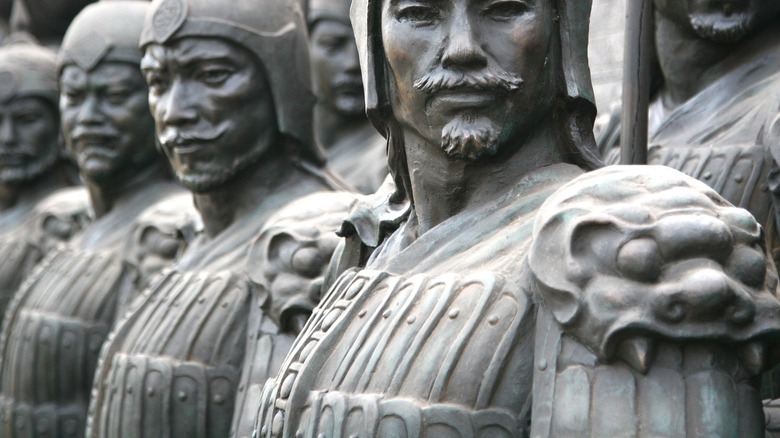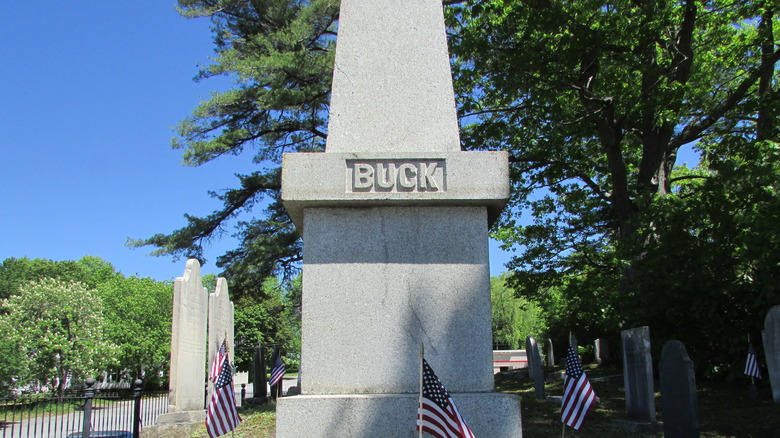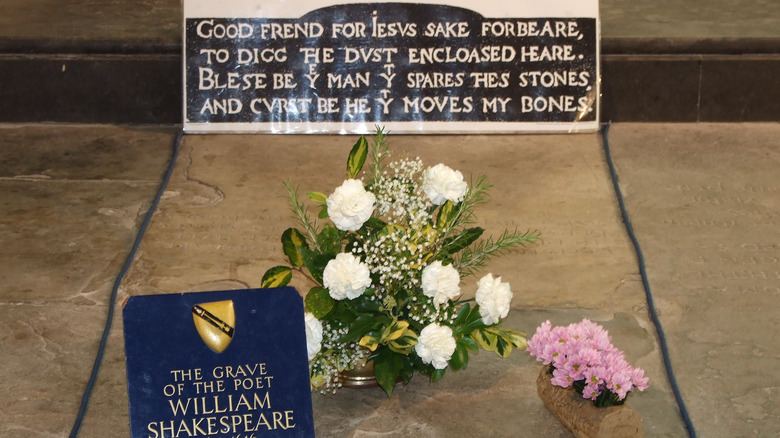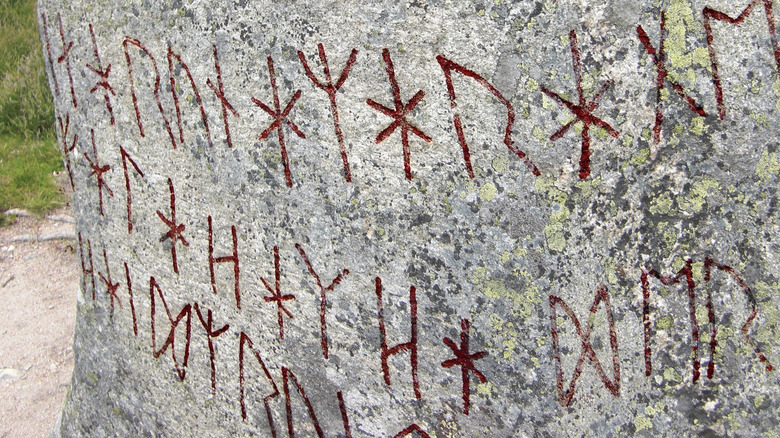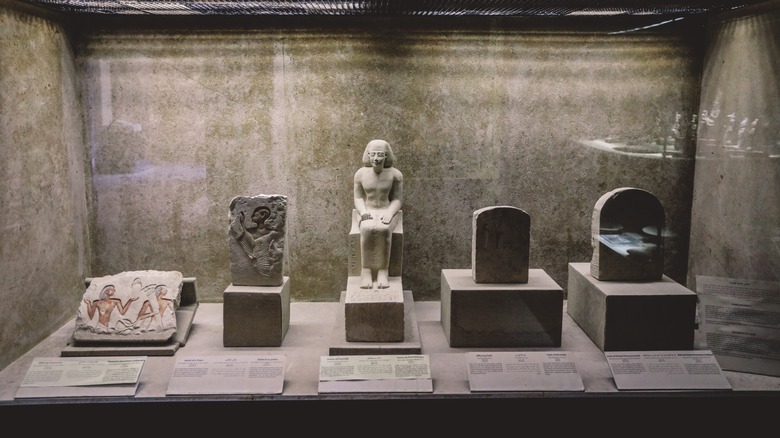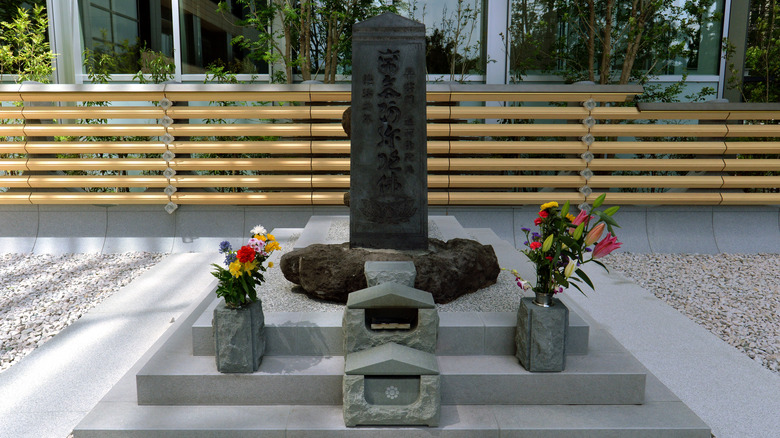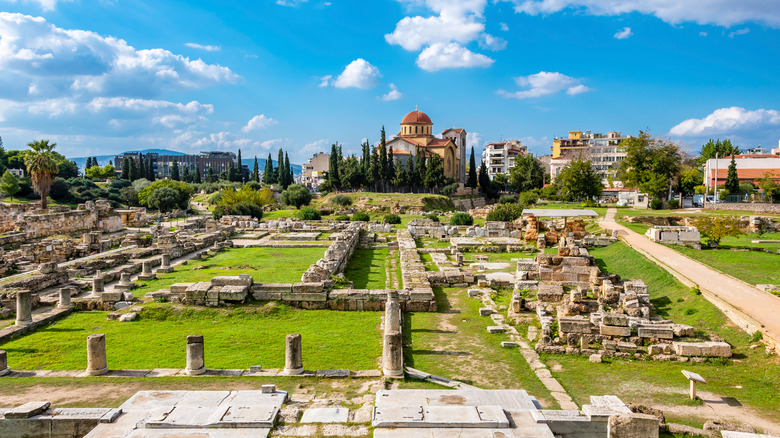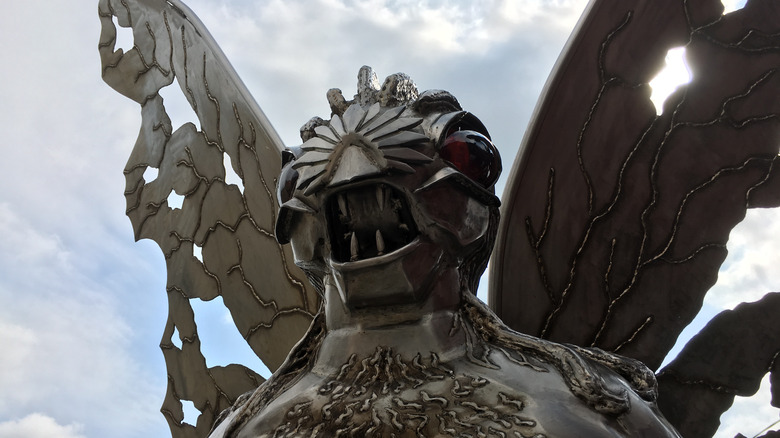History's Most Cursed Tombs
The idea of a cursed tomb or burial site has so many origins, many of which have become so popularized by Hollywood that it's hard to remember that they are actually grounded in some truth. "The Mummy" may well be the most popular movie adaptation, building off the concept of the curses that come from, as the title suggests, a mummy. But these kinds of curses aren't exclusive to Egypt. They just so happen to be the most explicit about their curses, inscribing them right on the sarcophagi where they can't be missed.
There's also the well-known consequences of building on Native American burial grounds. Readers Digest goes on an American trip to cursed places and, no surprise, a lot of them have to do with Native Americans getting a little post-death revenge on the colonial brutes who stole their land from them and disrespected sacred sites.
According to World History Encyclopedia, cursed inscriptions existed simply to prevent grave robbers. The dead and buried would have been fully aware that no curses actually existed. But for the robber, it might be enough to steer them towards another grave at least, another profession at best.
But that doesn't explain away all cursed tombs. There are still some that have brought death, destruction, and warnings of more that can't be explained away as coincidence. Here are the most cursed tombs in history.
Tutenkamen
You can't say "cursed tombs" without immediately thinking of the godfather of all cursed tombs — Tutankhamen. More commonly known as King Tut. A lot of things happened when King Tut's tomb was unearthed by an archaeological team in 1923, and it expanded beyond just the two men responsible for getting it started. Those two being archaeologist Howard Carter and his friend, George Herbert, Lord Carnarvon.
According to History, just two months after opening the tomb, George Herbert was dead of blood poisoning from a mosquito bite on his cheek. Media at the time offered their own sort of clickbait, saying Herbert fell victim to a curse that warned of death to those disturbing the royal graves in the valley.
The deaths didn't end with Herbert, however. According to Google Arts and Culture, his half-brother succumbed to blood poisoning as well. Others like Sir Archibald Douglas-Reid, a radiologist who examined the mummy, and George Jay Gould, who visited the tomb, met an early demise, And for still others, a slew of bad luck – Carter's friend, Sir Bruce Ingram, had his house burn down and later flood, thanks to a gift he was given that came from the tomb.
While a medical study from the National Library of Medicine sought to disprove the curse, it's hard not to see a common thread in the deaths.
Tamerlane
As Atlas Obscura details, Mikhail Gerasimov, a Soviet scientist, wanted to dig up the conqueror Tamerlane to reconstruct his face. That was kind of his thing as a doctor. He pioneered the field of paleo-anthropology, which is just another way of saying "reconstructing the dead."
Despite an outpouring of dissent from religious leaders, he dug up the body, ignoring two consecutive warnings on the tomb itself. The first warning was inscribed in plain sight and well known: "When I rise from the dead, the world shall tremble." The second was a surprise, hidden within the tomb itself: "Whomsoever opens my tomb shall unleash an invader more terrible than I."
Three days later, Germany launched Operation Barbarossa and invaded Russia. Few would argue that Adolf Hitler would qualify as an invader more terrible than Tamerlane. Those that dispute the curse (as summarized in Advantour) point out that Operation Barbarossa was already planned, and Hitler's terror was well underway before the invasion of Russia. Which is all well and good, but in 1942, when the body was finally returned and buried with full Islamic rites, the Battle of Stalingrad changed the course of the war for the Russians. Curse reversed, right?
Qin Shi Huang
What's so exciting about the tomb of Qin Shi Huang is that it's never been opened. But if his burial record (via ThoughtCo) is any indicator, there are enough traps inside to make an effective enough curse as is — notwithstanding the alleged curse the emperor himself placed. After all, according to the Liverpool Echo, it took 700,000 workers 36 years to build the tomb. Supposedly, many of those workers were buried alive inside the tomb to keep what's inside a secret. And it's worked. No one knows exactly everything that's in there.
However, there has recently been a cosmic ray surface scan of the grave to see what's inside (via the Daily Mail), but, needless to say, no curses will show up on a scan. You'll have to open the tomb to see what waits in that department.
There's also the matter of the potentially cursed Terracotta Army. According to an interview on Swiss Info with one of the men who accidentally discovered the emperor's army, there was a widespread belief that these statues were never meant to be seen by other men, and that it would bring great misfortune to the surrounding village — all because it was a major disruption of the dead emperor's feng shui.
While the Chinese government continues to protect the actual tomb of Qin Shi Huang, it will remain a mystery what sort of protection the emperor took with him to the grave.
Casimir IV Jagiellon
Poland has a bit of a broken history as a nation, but one of their brightest eras came thanks in part to King Casimir IV Jagiellon. Under his reign, according to Britannica, he famously subdued the Teutonic Knights once and for all, and he fought hard to retain the union between Poland and Lithuania — all the while recovering lost lands taken from previous kings. His efforts were largely successful, thus ranking him as one of Poland's most notable leaders. And his grave provided something of an impact as well.
Forty years after the mysterious circumstances surrounding King Tut's exhumation, a similar incident occurred in Poland at the tomb of Jagiellon. While Poland was a socialist country at the time, researchers were eager to figure out more about the king's death nearly 500 years after his funeral, according to Ancient Origins, and they dug right in.
Unfortunately, things did not go well for the excavation team. Unearthing the king under Wawel Chapel was easy enough, but it's the examination that started to claim so many lives. Even as the examination was in progress, those involved started to die from strokes and infections. Within days, four were dead. Within years, around 15 were dead.
While it has since been proven, according to History, that it was a fungus inside the coffin that was the cause of the death, there's always the possibility that maybe, just maybe, it was something more sinister.
Colonel Buck
While most curses involve death and at least a little casual destruction or threats thereof, Bucks curse is a bit timid by comparison. Yet, while other curses are proven away by medicine and science, this one has yet to have a simple explanation as to why it keeps happening.
The story takes place in Bucksport, Maine, named after the cursed man himself, Col. Jonathan Buck. According to Atlas Obscura, Buck, a revolutionary war hero, condemned a witch to death, and she delivered a very specific curse that her mark would forever be upon the monument over his grave (via the Bucksport government website). It's the specificity of the curse that makes it so interesting, because the curse was specifically applied to the monument built over his grave — which didn't actually get built until 75 years after his death.
Sure enough, as soon as it was built by Buck's family, the curse began. Right in the center of the monument, you can see the black outline of a leg and a pointed foot that no amount of washing can ever clean off. And while that foot is no active danger to anyone, it may be one of the best example of an inexplicable curse out there.
Shakespeare
William Shakespeare is known for a great many things. He is arguably the most famous writer of all time, his characters are household names, and his plays have been performed and remade by theaters across the globe. Which makes him an odd candidate for a cursed tomb, since it really has no reason to be, but it's there regardless, plain as day.
It starts with an inscription on the tomb itself. Shakespeare's own name isn't on the tomb, according to Reuters, but this inscription is: "Good friend, for Jesus' sake forbear, to dig the dust enclosed here. Blessed be the man that spares these stones, And cursed be he that moves my bones."
And yet, someone did move his bones. After taking a survey of the tomb, it became apparent that someone, at some point in time spanning about 400 years since his death, had dug up the coffin and taken something of a souvenir. According to archaeologist Kevin Colls (via Reuters), there is reason to believe that said souvenir was the bard's skull. Not to invoke any Hamlet parallels, of course. Who took it remains unsolved, but if Shakespeare's inscription meant anything, that thief is cursed. And perhaps that's why they've never been found.
The Björketorp Runestone
According to the National Museum of Denmark, Vikings regularly used runes in runic magic. By inscribing stones, they could wield the magical power of words. This magic could take the form of blessings or curses.
The Björketorp Runestone is one such example of what is undoubtedly some pretty nefarious runic magic. Located in Blekinge, Sweden, this stone is shrouded in mystery — both because of the inscription itself and the reasoning behind why it's needed. But all one has to do is give it a little read, and they'll understand that it's not here to summon good weather.
It's got a much darker purpose. According to Ancient Origins, it's likely attached to some sort of burial site and carries a warning: "I, master of the runes conceal here runes of power. Incessantly (plagued by) maleficence, (doomed to) insidious death (is) he who breaks this (monument). I prophesy the destruction/prophecy of destruction."
Sounds pretty awful. Thankfully no one has succeeded in breaking the monument, whatever it's there to protect.
Saqqara Tomb
Saqqara, the ancient Egyptian city of the dead, is right up there with King Tut for the most popular burial site in Egypt. It can also trace its origin all the way back to the First Dynasty, where it hosted burials for more than 3,000 years, according to Smithsonian Magazine. In the rich history of Egypt, 3,000 years of royal burials can accumulate quite the cast of characters, many of whom would have wanted to protect themselves and their riches into the afterlife.
All this to say, this is a massive chamber with curses all around. In fact, there is so much buried there that, according to Business Insider, they have turned up over 160 different sarcophagi. And no sarcophagi would be complete without a few curses inscribed on it to prevent grave robbers or to genuinely curse them.
One example Business Insider provides is the burial of Ankhmahor. His sarcophagus essentially warns that whatever is done against his tomb "the same shall be done to your property." It also warns that any "impure" trespassers will be filled with the fear of seeing ghosts.
This doesn't sound all that horrible compared to the death and destruction of other curses, but a curse is a curse. In terms of curses-per-square-foot, there can't be any higher in the rankings than Saqqara, the City of the Dead.
Taira no Masakado
Taira no Masakado, the very first samurai, is also apparently still the standard-bearer for the age-old warrior class of Japan. According to the Guardian, the story of Masakado's life is just as exciting as his death. His head is his Achilles heel. It's the only place his serpent mother forgot to lick. But other than that he was completely invincible, according to legend. So his enemies cut off his head, which is the only thing that's left buried. And that's just his life.
When the Ministry of Finance burned down during an earthquake in 1923, the superstitious Japanese emperor blamed Masakado — over a 1,000 years dead (via Atlas Obscura). The state planned to rebuild the ministry on top of Masakado's grave, but then people started die. Fourteen lives were lost within five years on the premises, and after the death of the finance minister himself, plans were abandoned.
The incidents continued. So much so that, as the Guardian says, even the occupying United States Army refused to touch it in 1945. When a bank built a branch on the location, they quickly found themselves declaring bankruptcy in 2002 and, in a last-ditch effort, opened an account in Masakado's name. It didn't help.
Nowadays, there's a small garden dedicated to Masakado's memory, and you can bet no one is going to be building there any time soon.
Nostradamus
It's not surprising that the man who could predict the future sought to protect his resting place with a curse — as well as a prediction of when his tomb would be raided. After all, nothing about Nostradamus is ever complete with a good prediction or two.
In a quintessential Nostradamus quatrain, he calls out whoever would dare disturb his tomb: "He who will open the tomb found/And will come to close it promptly/Evil will come to him, and one will be unable to prove/If it would be better to be a Breton or Norman King."
A report from York University goes into detail about what may or may not have happened when the tomb of Nostradamus was disturbed in 1793. In the heat of the French Revolution, French soldiers went after the fabled tomb, ignoring the supposed rumor that whoever opens the tomb would be killed. And that doesn't even include what Nostradamus threatened in his predictive poetry. But this is where the story gets a little fantastical. It's said that the soldier who opened the tomb found a sign around Nostradamus's neck that predicted that exact date.
After drinking wine out of his skull (which is generally never a good idea), the soldier was then killed by a stray bullet. While that is all incredibly unlikely, the lore surrounding the tomb and its curses are still fabled to this day.
Seath Mór Sgorfhiaclach
Far off the beaten path, in the dense Scottish forest of Rothiemurchus, lies a grave of a rather peculiar and dark history. It is the final resting (if he's doing much resting) place of Seath Mor Sgorfhiaclach, a 14th-century Scottish chieftain of Clan Shaw, according to Scottish Field. The chieftain was a fearsome warrior, with the temperament of a battle-hardened soldier, and he carried those traits on into death as well.
The story goes that a giant figure awaits all who approach, challenging them to battle. If accepted, he lets them pass. But those who show fear are never seen again. That's not the whole of what this grave can do, though.
According to the "More Strange Scotland," by Jack Strange, the five stones that sit atop the grave are also part of the curse. It's said that, over the years, visitors who have moved the stones have met with a rather unkind fate. Namely, death. And apparently this got so serious that the keepers of the graveyard had enough of the visitors trying to stir up the dead chieftain, so they installed a metal grate over the grave and stones to prevent anyone from messing with them ever again (via HistoryHit).
Kerameikos
The Kerameikos cemetery dates all the way back to the Bronze Age (2700-2000 B.C.E.), according to the Greek Ministry of Culture and Sports. Considering how widespread the Greeks were at the height of their empire, it's no wonder this burial site became a crucial location in ancient Athens.
Newsweek reported that, in 2020, a collection of 30 inscribed tablets were found at the bottom of a 2500-year-old Athenian well in the ancient cemetery of Kerameikos. Which sounds cursed enough as is, but the tablets bear individual curses and prayers to the Greek gods of the underworld.
Jutta Stroszeck, who led the excavation (via Haaretz), said that whoever ordered the curses inscribed on the tablets was unnamed, but the black magic is present and there for all to see, even though black magic was forbidden in Greece at the time.
While the well was only just found in 2016, the cemetery itself was first excavated in 1870, as per the Greek Ministry. Progress halted when World War II broke out, and everybody involved in the excavation died in the war, according to Haaretz. While it's hard to pin that one on the curse itself, it does follow the trend set by King Tut. Death just so happens to find those that disturb these tombs.
Chief Cornstalk
Native American burial grounds have a long history of messing things up, but in terms of specific graves, it's Chief Cornstalk who enacted what might be one of the most menacing curses around.
A Shawnee leader, Cornstalk had a massive role to play in the formulation of West Virginia, according to the State site, but according to travel blog Roadside America, there was a bit of vengeance at stake too. When American soldiers murdered him, Cornstalk managed to utter a curse on the land before he died. That land, of course, is Point Pleasant. His exact words, according to the Marietta Times, were, "For this may the curse of the Great Spirit rest upon this spot. May it be cursed by nature. May its hopes be forever blighted ..."
The Marietta Times also points out that plagues and disasters hit Point Pleasant and the surrounding area. And the monument of the battle itself, which is also where Cornstalk is buried, was struck by lightning.
And, if the name Point Pleasant sounds familiar, it's because it's the site of the infamous Mothman sightings and all of the accompanying incidents. The West Virginia state website mentions that Cornstalk and the Mothman are spoken in conjunction with one another, as if this cryptid is the return of Cornstalk's age-old curse.
